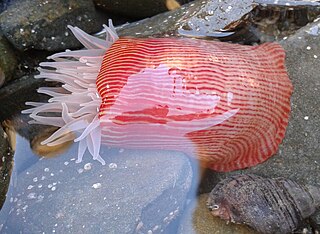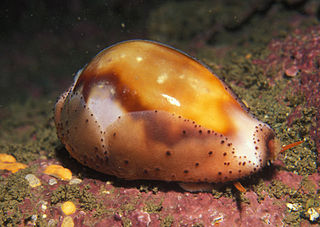
Pseudoceros dimidiatus, the divided flatworm or tiger flatworm, is a species of flatworm in the genus Pseudoceros, belonging to the family Pseudocerotidae.
Phoronis psammophila is a species of marine horseshoe worm in the phylum Phoronida. It lives in a tube projecting from the sea floor in shallow seas around the world.

Euryleptidae is a family of marine polyclad flatworms.
Maritigrella crozierae, the tiger flatworm, is a species of marine polyclad flatworm in the family Euryleptidae. It is found on the eastern coasts of North America and the Caribbean Sea where it feeds on colonial sea squirts.
Pseudoceros goslineri, the Gosliner flatworm, is a marine flatworm species that belongs to the family Pseudocerotidae.

Thysanozoon nigropapillosum is a species of polyclad flatworms belonging to the family Pseudocerotidae. Some common names include gold-speckled flatworm, marine flatworm, yellow papillae flatworm, yellow-spotted flatworm, and yellow-spotted polyclad flatworm.
Anthopleura thallia, commonly known as the glaucous pimplet, is a species of sea anemone in the family Actiniidae. It is found in shallow water in the northeastern Atlantic Ocean and the Mediterranean Sea.

Endeavouria is a monotypic genus of land planarians from the Pacific region. It contains a single species, Endeavouria septemlineata.

Epiactis thompsoni, the red-striped anemone, is a species of marine invertebrate in the family Actiniidae, found in New Zealand and South Australia. They are commonly found in the rocky intertidal zone.
Kaburakia excelsa, the giant flatworm or giant leaf worm, is a species of flatworm found on the lower shore and shallow water in the eastern Pacific Ocean. It occurs on the lower shore and shallow sub-littoral zone.

Neobernaya spadicea, common name the chestnut cowrie, is a species of sea snail in the cowrie family, Cypraeidae. Chestnut cowries can be found in the eastern Pacific Ocean, from central California to Baja California. The chestnut cowrie has a highly glossy shell due to an enamel that is secreted from its mantle.

Coeloplana astericola, the creeping comb jelly, is a species of benthic comb jelly from the tropical western Indo-Pacific region that lives as an episymbiont on starfish such as Echinaster luzonicus.

Procerodes littoralis is a species of triclad flatworm widely distributed on the shores of northwestern Europe and on the east coast of North America from Newfoundland northwards.
Nephasoma minutum is a marine invertebrate of the phylum Sipuncula, commonly known as peanut worms because of their shape when contracted. It is a cylindrical, unsegmented worm with a crown of tentacles around the mouth. These worms live in crevices in the rocks or in burrows in shallow water in Western Europe, and the eastern United States.
Acrocnida brachiata, the sand burrowing brittlestar, is a species of brittle star in the family Amphiuridae. It occurs on the seabed in the northeastern Atlantic Ocean and the North Sea, living semi-buried in the sand with only its arm tips projecting.
Macrostomum rostratum is a free-living, hermaphroditic flatworm in the family Macrostomidae, found in freshwater and brackish environments.

Pawsonia saxicola, the sea gherkin, is a species of sea cucumber in the family Cucumariidae. It is found in the northeastern Atlantic Ocean and the Mediterranean Sea.
Thyone fusus is a species of sea cucumber in the family Phyllophoridae. It is found on the seabed in the northeastern Atlantic Ocean and the Mediterranean Sea. It is a suspension feeder and catches food particles floating past with its branching feeding tentacles.

Lottia instabilis is a species of sea snail, a true limpet, a marine gastropod mollusk in the family Lottiidae. Common names include the unstable limpet, the unstable seaweed limpet and the rocking chair limpet. It is native to the northern Pacific Ocean where it feeds on kelp in the intertidal zone and the shallow sub-littoral zone.
Thyone roscovita is a species of sea cucumber in the family Phyllophoridae. It is found on gravel, sand and mud substrates in the northeastern Atlantic Ocean and the Mediterranean Sea at depths down to about 40 m (130 ft). It is a suspension feeder and catches food particles floating past with its branched feeding tentacles.










